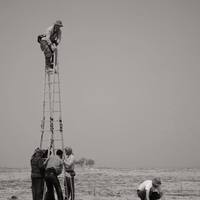Papers by Gvantsa Vachadze

HISTORY, ARCHAEOLOGY, ETHNOLOGY , 2023
This paper is about a translucent glass feature, namely beads found in N1 and N2 collective buria... more This paper is about a translucent glass feature, namely beads found in N1 and N2 collective burial pits at Tsaishi cemetery, located in western Georgia, Central Colchis. Artefacts are preserved in the Dadiani Palace History and Architectural Museum. Among finds of vitreous material the discovery of translucent glass artefacts in pale or relatively intense colours is a new phenomenon within the archaeological sites of Georgia during the first quarter of the first millennium BC. Through a multidisciplinary study of this new type of glassware, we were able to discuss the local and external factors that contributed to its appearance in Iron Age Colchis. In the initial stage a typological study of beads was carried out. Four types and eight subtypes were distinguished and the characteristics and persistence of certain types in different chronological contexts were examined. A comparative analysis was carried out between the contemporary translucent glass products found in the archaeological sites of Georgia and the Caucasus, as well as the Near East, the Mediterranean and Etruria. The next step involved laboratory analysis to determine the primary raw materials used for the production of Tsaishi glasses and the main pigments used for their colouring.
This book deals with zoomorphic bronze statuettes in the territory of Colchis, in the time course... more This book deals with zoomorphic bronze statuettes in the territory of Colchis, in the time course of 1st half of the 1st millennium BC.
Some of these materials were unearthed by the Archaeological Expedition of Colchis in the 1970s, but our research revealed hitherto unknown artefacts in the archaeological collections of the Georgian National Museum and Regional Museums.
The appearance of the bronze round statues in Colchis is discussed in general historical-cultural context. The stylistic analysis of the sculptures compares with local zoomorphic shapes as well as animal sculptures from neighboring archaeological cultures. Figurines from Northern Caucasus, Luristan and Greek archaeological sites are included in the work.
Main results are given in English.

Research of VIII-VII century Colchian culture and its interaction with surrounding civilizations ... more Research of VIII-VII century Colchian culture and its interaction with surrounding civilizations is very much centered around the bronze statues of women, riding the horses; Given sculptures were mostly found in signature Colchian collective graves. Interest towards Colchian sculptures was triggered by the discovery of similar statue in Greece, in Herayon, Samos Island.
This type of iconography was not characteristic for Colchian culture, especially till VIII - th century BC. Hence, appearance of these statues is the result of import from outside, neighboring civilizations. Side seated raiders and their sculptures are characteristic for Greek and Eastern cultures. Side seated figurine of the woman can be seen in Museum of Israel (Jerusalem); VIII-VII century BC. figurine is made in bronze. Along with statue of men, with a cup in one hand, this group of statues have many analogies with ones recovered in burial places of Luristan. Besides, side seated horse rider sculptures of late bronze period are met in Greece, Crete and Cyprus. Terracotta figurines, also from late bronze period are discovered in Festos and Syllamos, where goddess is side seated on riding horse, with hands diverted to sky. Lately, similar sculptures are mostly met in Pelopones archaeological fields.
When compared, Colchian figures are found to have more similarities with Greek items, than with ones discovered in Eastern lands. We can conclude that these patterns of sculptures were born in Colchis region, as a result of interaction with western civilizations. Story looks similar with appearance of bronze Fibulas and minor bronze items, Mukhurcha statues of bull or charioteer serve as an example. Items recovered in Lorestan are dissimilar, riders look stylistically different, but what they have common is their presence in burial places, seemingly having different outlines but maybe similar purpose. Unlike Colchis and Luristan nations, Greeks were using respective statues only inside altars for sacred rituals.
Statues of horse riding women recovered in Colchian culture have many unique details. After adopting the sculptures and integrating them into daily life, it seems Colchis soon introduced their own characteristic patterns of manufacturing the items, heavily influenced by the local past, and these statues finally found their honorable place in Colchian culture of VIII-VII centuries BC.
Bronze statuettes of bulls found in Colchis in VIII-VII CC. BC, 2018
Patrocinio Angela Pontrandolfo, Michele Scafuro (a cura di), Atti del I Convegno Internazionale d... more Patrocinio Angela Pontrandolfo, Michele Scafuro (a cura di), Atti del I Convegno Internazionale di Studi ISBN 978-88-87744-76-7 (cinque tomi indivisibili) © Copyright 2017 -Fondazione Paestum -Pandemos s.r.l. Proprietà letteraria riservata Con il supporto economico di C O PI A A U TO R E. VI ET A TA LA D IF FU SI O N E. Paestum, 7-9 settembre 2016 a cura di Angela Pontrandolfo, Michele Scafuro del I Convegno Internazionale di Studi ATTI FONDAZIONE PAESTUM
Talks by Gvantsa Vachadze
The Iron Age land use on the steppes and plains of Eurasia is primarily associated with nomads. C... more The Iron Age land use on the steppes and plains of Eurasia is primarily associated with nomads. Classical authors name people such as "Scythians" and "Cimmerians", who are geographically assigned to specific regions, related to various migrations or raids, and generally appear as "mobile". Kurgans, burial remains visible in the flat landscape have attracted most archaeological attention, although several settlements of the period have also been archaeologically investigated.










Uploads
Papers by Gvantsa Vachadze
Some of these materials were unearthed by the Archaeological Expedition of Colchis in the 1970s, but our research revealed hitherto unknown artefacts in the archaeological collections of the Georgian National Museum and Regional Museums.
The appearance of the bronze round statues in Colchis is discussed in general historical-cultural context. The stylistic analysis of the sculptures compares with local zoomorphic shapes as well as animal sculptures from neighboring archaeological cultures. Figurines from Northern Caucasus, Luristan and Greek archaeological sites are included in the work.
Main results are given in English.
This type of iconography was not characteristic for Colchian culture, especially till VIII - th century BC. Hence, appearance of these statues is the result of import from outside, neighboring civilizations. Side seated raiders and their sculptures are characteristic for Greek and Eastern cultures. Side seated figurine of the woman can be seen in Museum of Israel (Jerusalem); VIII-VII century BC. figurine is made in bronze. Along with statue of men, with a cup in one hand, this group of statues have many analogies with ones recovered in burial places of Luristan. Besides, side seated horse rider sculptures of late bronze period are met in Greece, Crete and Cyprus. Terracotta figurines, also from late bronze period are discovered in Festos and Syllamos, where goddess is side seated on riding horse, with hands diverted to sky. Lately, similar sculptures are mostly met in Pelopones archaeological fields.
When compared, Colchian figures are found to have more similarities with Greek items, than with ones discovered in Eastern lands. We can conclude that these patterns of sculptures were born in Colchis region, as a result of interaction with western civilizations. Story looks similar with appearance of bronze Fibulas and minor bronze items, Mukhurcha statues of bull or charioteer serve as an example. Items recovered in Lorestan are dissimilar, riders look stylistically different, but what they have common is their presence in burial places, seemingly having different outlines but maybe similar purpose. Unlike Colchis and Luristan nations, Greeks were using respective statues only inside altars for sacred rituals.
Statues of horse riding women recovered in Colchian culture have many unique details. After adopting the sculptures and integrating them into daily life, it seems Colchis soon introduced their own characteristic patterns of manufacturing the items, heavily influenced by the local past, and these statues finally found their honorable place in Colchian culture of VIII-VII centuries BC.
Talks by Gvantsa Vachadze
Some of these materials were unearthed by the Archaeological Expedition of Colchis in the 1970s, but our research revealed hitherto unknown artefacts in the archaeological collections of the Georgian National Museum and Regional Museums.
The appearance of the bronze round statues in Colchis is discussed in general historical-cultural context. The stylistic analysis of the sculptures compares with local zoomorphic shapes as well as animal sculptures from neighboring archaeological cultures. Figurines from Northern Caucasus, Luristan and Greek archaeological sites are included in the work.
Main results are given in English.
This type of iconography was not characteristic for Colchian culture, especially till VIII - th century BC. Hence, appearance of these statues is the result of import from outside, neighboring civilizations. Side seated raiders and their sculptures are characteristic for Greek and Eastern cultures. Side seated figurine of the woman can be seen in Museum of Israel (Jerusalem); VIII-VII century BC. figurine is made in bronze. Along with statue of men, with a cup in one hand, this group of statues have many analogies with ones recovered in burial places of Luristan. Besides, side seated horse rider sculptures of late bronze period are met in Greece, Crete and Cyprus. Terracotta figurines, also from late bronze period are discovered in Festos and Syllamos, where goddess is side seated on riding horse, with hands diverted to sky. Lately, similar sculptures are mostly met in Pelopones archaeological fields.
When compared, Colchian figures are found to have more similarities with Greek items, than with ones discovered in Eastern lands. We can conclude that these patterns of sculptures were born in Colchis region, as a result of interaction with western civilizations. Story looks similar with appearance of bronze Fibulas and minor bronze items, Mukhurcha statues of bull or charioteer serve as an example. Items recovered in Lorestan are dissimilar, riders look stylistically different, but what they have common is their presence in burial places, seemingly having different outlines but maybe similar purpose. Unlike Colchis and Luristan nations, Greeks were using respective statues only inside altars for sacred rituals.
Statues of horse riding women recovered in Colchian culture have many unique details. After adopting the sculptures and integrating them into daily life, it seems Colchis soon introduced their own characteristic patterns of manufacturing the items, heavily influenced by the local past, and these statues finally found their honorable place in Colchian culture of VIII-VII centuries BC.